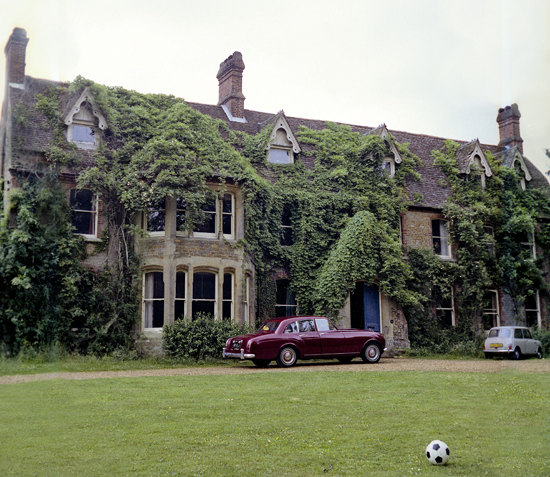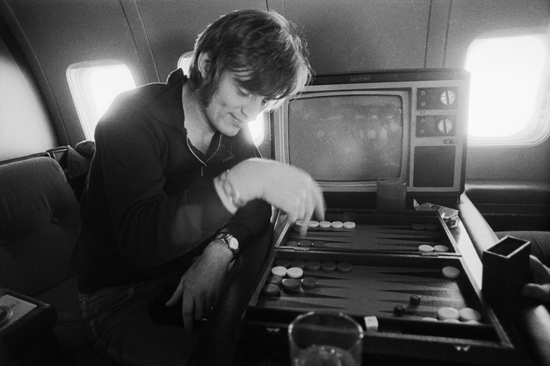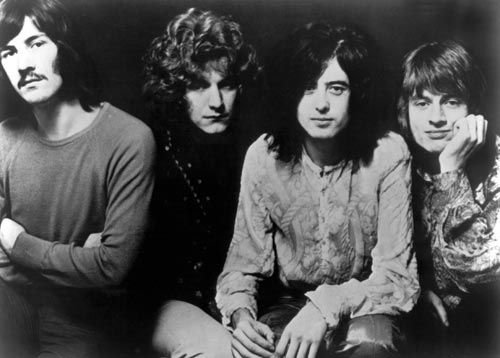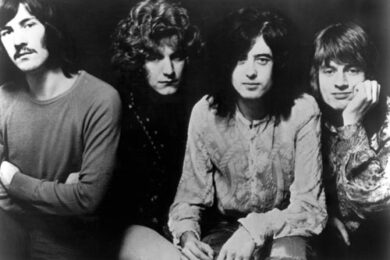Something’s rotten in the state of rock. The euphoria of the late ’60s has declined into decadence. Working-class guitar heroes have become cosseted pseudo-aristocrats in limousines. The music itself is becoming ever more self-satisfied. Double and even triple albums proliferate as artists lose all traces of humility. No one had ever imagined that rock & roll could get so pretentious: how did we get from Elvis’ Sun sessions to Yessongs?
Where are the street fighting men? Holed up in hotels with mounds of blow and women eager to demean themselves. Or evolved into preening virtuosos lost in misplaced notions of their own genius. A sense of enervation grips even these gods as they turn for inspiration to their ’50s and ’60s roots on covers albums like Pin-Ups, Rock’n’Roll, These Foolish Things and Moondog Matinee.
True, there are rumblings of discontent from CBGBs rebels ready to kick over the old statues. And true, reggae has delivered its first global icon in Bob Marley. Glam rock throws lifelines to Lou Reed and Iggy Pop, but in America they mean little. The masses prefer Wings, Chicago, Rod Stewart and Bachman-Turner Overdrive.
And what of the biggest band of all? The mighty Led Zeppelin, coming off the back of an insanely successful 1973 US tour that packed 56,800 worshippers into Tampa Stadium in Florida and in so doing broke the Beatles’ attendance record. The news that the group’s next release will be a double album does not fill the hipper critics with unbridled enthusiasm.
Granted, Zeppelin aren’t ELP, but in many ways they remain exemplars of "progressive" rock, turning ‘Dazed and Confused’ and ‘No Quarter’ into half-hour live epics of meandering self-indulgence. Whatever else it is – the most played record on radio ever, etc – ‘Stairway to Heaven’ is the slow-building prog-rock anthem to end them all.
Let’s not forget that Led Zeppelin are the band who, more than any other, declared war on the 45 rpm single by refusing to release an edit of ‘Whole Lotta Love’. For the snot-nosed punks of London and Manhattan, Zeppelin are THE ENEMY, the ultimate dinosaur; Paul Simonon will famously exclaim that merely looking at one of Led Zeppelin’s album covers is enough to make him feel sick.
The new album in question is late. When Zeppelin commence their 1975 US tour in January, the record is still not in the stores. Is it any good? Will it be Zeppelin’s Exile On Main St. or their Tales From Topographic Oceans? It could so easily be a high-watermark of aloofness – maybe even a Swan Song, the name of the new label on which it is being released.
After the relatively unloved Houses Of The Holy – the proggiest but also the most underrated of all Zeppelin’s albums – will Physical Graffiti be a new beginning? Or could it be the end?
Here, then, is the oral story of Zeppelin’s classic 1975 double:
Jimmy Page (speaking in 1975): When I came back from the last tour I didn’t know where I was. I didn’t even know where I was going. We ended up in New York and the only thing that I could relate to was the instrument onstage. I just couldn’t… I was just totally and completely spaced out.
Richard Cole (road manager for Led Zeppelin): When we went back to Headley Grange to do the next album, I put Robert, Bonzo and John Paul into a hotel called the Frencham Pond. Jimmy wouldn’t stay there. He was quite happy in that fucking horrible cold house.
Ron Nevison (engineer on Physical Graffiti sessions): I drove the Ronnie Lane mobile unit down to Headley. It was state-of-the-art with a Helios console, the same one the Stones had in their truck, sixteen tracks like most of the big studios had.

I’d made a commitment to Pete Townshend to start the Tommy film in late January. Because of Jonesy not appearing for a week, I had to ask at one point to leave the project, and I don’t think anybody in the history of Led Zeppelin had ever quit a project before. When I called up and told them I couldn’t continue, they were really nasty to me on the phone. They all shouted and screamed at me, and it was very upsetting. Especially Bonham, who called me all sorts of names.
Robert Plant (speaking in 1975): It’s always a case of getting together and feeling out the moods of each of us when we meet with instruments for the first time in six months. We began as always, playing around and fooling about for two days, playing anything we want, like standards, our own material or anything that comes to us, and slowly but surely we develop a feel that takes us on to the new material.
Some of the new stuff came directly from this approach, like ‘Trampled Under Foot’, which was just blowing out, and some comes from Jonesy or Pagey or myself – seldom myself – bringing along some structure which needs working on. Then the four of us inflict our own venom on it to develop the idea.
Ron Nevison: My biggest fan during the whole recording was Robert, who loved the effect I got on his vocals – probably because I wasn’t a guy who looked at meters. I was taught early on, don’t listen to the speakers, listen to the music.
The drum kit was set up where it had been set up for the fourth album. I put mics all around it and Bonham told me to take them down. I said, "Well, just in case…" and he said, "No, not just in case – take them down". So I took them down and they showed me where to put the microphones where they’d used them before.
Robert Plant: Bonzo came in with this really nice driving tempo, really laid back sort of shoom shoom. And we thought, "Mandrax? No." And having been travelling a little bit to get the feel of foreign lands, the song developed from that shoom shoom… and with a touch of the east, a little bit of cholera on the arm… what we had left was ‘Kashmir’.
Benji LeFevre (vocal technician for Robert Plant): Eventide Clockworks gave me innovative bits of electronics and I just played with them. Robert’s voice would become a chorus of ten voices, because I would feed things back into themselves. And then we had this harmoniser with an actual keyboard so I could make his voice sing chords. It was fantastic fun.
Ron Nevison: I’d heard that Eventide phasers sounded great on cymbals so I brought one in for ‘Kashmir’. I only had two tracks for drums, so what I did was set up the phaser and put one of the tracks through it, just for the hell of it. And they loved it and kept it in, and that’s part of the whole sound of ‘Kashmir’.
Peter Grant (manager of Led Zeppelin): They’d go off to recordings… and I’d get a call from Bonzo: "Oh, you’ve got to come down. We ain’t half done something today." I remember particularly ‘Kashmir’ – "Come down! Come down! Get in the Porsche and get down here!"
Benji LeFevre: Bonzo and Robert arrived at Headley in Bonzo’s brand-new BMW and Bonzo goes, "’Ere, Benj, look what I’ve got". And he had a bag of about fifteen hundred Mandrax. I thought, "Well, this is gonna be a good session, isn’t it". He was handing them out like sweeties, saying, "Don’t tell Robert…" I said, "Bonzo, you’d better fucking stash these somewhere". So a little later he said to me, "Come and look". He’d taped them to the inside of his tom-tom – forgetting of course that it was a Perspex kit so we could all see it.
Ron Nevison: I was pretty naïve. They kept saying, "When’s Charlie coming?" And I never met Charlie. There was a decided change in the vibe after Charlie came.
Benji LeFevre: In the mornings at Headley, us mere mortals used to go round the sitting room picking up rocks of coke to make our own stashes.
Gyl Corrigan-Devlin (friend of Zeppelin’s): I can remember the night when everything got a little scary for me at Headley. I was worried about Bonzo, I think, because he’d have finished the wine at dinner and then he’d get stuck into the Jack Daniels. And that was the first time I’d spent time with him at the kitchen table, as it were. This wasn’t on the road, he wasn’t coming down from anything. And he would get sad at the end of the night and say he wanted to go home.
Vanessa Gilbert (friend of Zeppelin’s): After the 1973 tour I was in England for about six months. I was staying near Hampstead Heath with Gyl. One evening the phone rings and it’s Peppy, one of their road guys: "We’re here at Headley Grange and John Paul wants to see you." I said, "Where’s Headley Grange?" I hang up the phone and two seconds later BP Fallon [Zeppelin press officer] calls right there and then. Now he wants to go to Headley Grange.
The taxi couldn’t find the exact location, so we pulled over at a phone box and called Peppy, who came and got us in Bonzo’s brand-new BMW. Peppy starts bouncing the car off at least five different obstacles. We’re holding on for dear life in the back seat. When we get in the house, John Paul’s got his face in, like, a pile of spaghetti – he’s on Mandrax or something and he’s talking real slow. BP, who’d probably also taken a couple of Mandrax, went to sleep in a little bedroom and the guys went outside into the garden with the sheep and herded them into Beep’s room. Like, "How many farm animals can we get into this room?" Poor Beep.
Gyl Corrigan-Devlin: Vanessa and John Paul were great friends: they’d sit in the corner and read Henry Miller’s Big Sur and the Oranges of Hieronymous Bosch together.
John Paul Jones: I just started playing ‘Trampled Under Foot’ on the clavinet, and [John] came in with this glorious stomp that had this great feel. He could play in front of the beat and he could play behind it, depending on what was needed it. ‘Trampled Under Foot’ had this swagger; it was a different type of song for the band.

John Bonham: John, Paul and Jimmy started off the riff, but then we thought it was a bit souly for us. Then we changed it around a bit. It’s great for me. Great rhythm for a drummer. It’s just at the right pace and you can do a lot of frills.
Jimmy Page: With Physical Graffiti you can see all the different things that we were able to do that people can’t do now – constantly working in a positive way, for no other reason than making good music. It wasn’t to be on Top of the Pops or to be doing an interview.
Ron Nevison: Jimmy was so well-prepared. He used to come into the truck and he’d listen to the whole thing. At that time I thought he just didn’t like his guitar. But then I realised that he was doing what I do now, which is to take the guitar down to make sure the drum track is solid. The essence to me of the whole Zeppelin thing was John Bonham following the guitar. He would take the riff and he would make that his drum part. If you listen to ‘Sick Again’ or any other song, he listened to the riff and he made it the drum part. Instead of just doing it 4/4 and getting in with the bass player, he got in with the guitar player.
Phil Carlo (road manager for Swan Song band Bad Company): I remember Jimmy coming round to the flat with Keith Harwood, the engineer at Olympic. They’d just done ‘Kashmir’ and Jimmy was absolutely thrilled to bits with it. He seemed to be more pleased with that than anything they’d ever done.
Danny Markus (artist relations manager in Atlantic’s midwest office): Apart from Ahmet and Jerry [Greenberg], nobody at Atlantic heard Physical Graffiti till it came out. The mystique was very well orchestrated.
Jaan Uhelszki (in Creem, May 1975): The fans descended on Marty’s Records downstairs from Creem like dragonflies, clustered around the cash register, furtively clutching the album to their heaving bosoms, slobbering and drooling down the shrinkwrap.
Danny Markus: In many respects the audience was ahead of the company. Everyone knew internally that the next Zeppelin record was going to be really big, but I never saw an album sell as much as Graffiti. You’d go to stores and there were lines and everybody was waiting to buy the same record.
Trampled Under Foot: The Power and Excess of Led Zeppelin is published by Faber & Faber
Barney Hoskyns will be discussing Led Zeppelin at tonight’s Faber Social in the company of former Zep road manager Phil Carlo and sometime NME legends Keith Altham and Charles Shaar Murray. 7 pm at the Social, 5 Little Portland Street, London W1W 7JD



